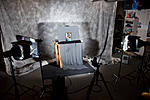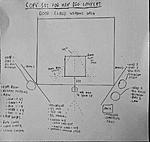Obviously, this works for you, but the diffusers are limiting the contrast you can achieve. You've already got a polarizer on the camera; however, the lights themselves should also have polarizers. Ditch the diffusion panels and get a large polarizer sheet for one Speedo head on each side. Hang the sheets with the polarization arrow the same for both sheets. My old Roscoe polarizers work best with the arrows vertical when the lights are as you have. (Other manufacturers may have the polarization marked differently.) Then use the modeling lights to adjust the polarizer on the camera for maximum contrast. Use barn doors on the lights to limit stray light bouncing around the room and hang dark cloth on the wall behind, again to limit stray bounces.
With this arrangement, you'd be able to shoot your prints, even if they're framed behind glass.





 Reply With Quote
Reply With Quote



Bookmarks